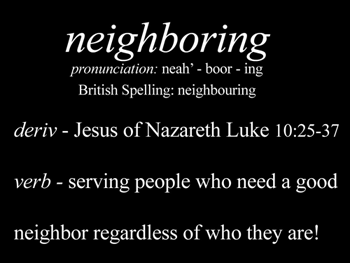"So just who is my neighbor?" This question was launched by an expert on the Old Testament law to test Jesus. While it may seem innocent enough at first glance, underneath it was the push to find out just what is needed to qualify for eternal life (Luke 10:25). To put it crassly, "What's my minimum requirement on being neighborly?"

Jesus addressed the question in three powerful ways, never letting the "expert in the law" off the hook . Jesus was going to make sure this expert had to "own" his answer. Jesus asked the man to state his understanding of God's truth twice, rather than Jesus giving the "expert" an answer (Luke 10:26; Luke 10:36).
First, Jesus made clear the issue is about "neighboring": intention and emotion are important, but godly compassion always involves action (James 2:14-17; 1 John 3:16-17). Jesus made this powerfully clear by answering the question by telling the story of "the good Samaritan" (Luke 10:30-35). The question is not, "Who is my neighbor [who I must serve]?" Instead, the question is, "Who needs neighboring: who needs my help and support?" And Jesus frames the story by the emphasis on "doing compassion" by framing the story with these two phrases: (1) "Do this and live" (Luke 10:28 TNIV), and (2) "Go and do likewise" (Luke 10:35).
Second, Jesus demonstrated what it means to "love your neighbor as yourself." A simple scan of Matthew, Mark, Luke, and John - the books in the Bible that tell the story of Jesus - help us understand just what "neighboring" means. We meet men and women, religious and non-religious, leaders and powerless, rich and poor, able-bodied and those who are sick, dying, and dead. Jesus simply ignored the categories we so easily force people to fit. He broke social barriers, gender barriers, and religious stereotypes. He did not meet someone who was not his neighbor and he calls us to live the same way.
Third, Jesus always kept the command to "love your neighbor as yourself" connected to "Love the Lord your God with all your heart and with all your soul and with all your strength and with all your mind" (Luke 10:27). We become like the One we love! We cannot love God and not love others (1 John 4:7-21).
So what's the point of all of this? Simple: it's not about figuring out who is our neighbor, but about neighboring those around us in need!
Make a list of all the different kinds of people Jesus served - take a quick scan of the gospels to remind yourself of all the different kinds of people Jesus' life touched in a redemptive way (Matthew 8:1-38; Mark 9:1-50; Mark 3:1-64; Luke 7:1-50 are a good start).
What do you think the message is for you and how you are to "neighbor" others based on Jesus' example?
How would you describe what "neighboring" others means in your daily life?
What leads you to keep from "neighboring" those who need our help?
What makes it hard "neighboring" others you may not know?
What makes it hard "neighboring" those you do know?
I'd love to hear from you on my blog about this:
http://www.heartlight.org/thephilfiles/2009/02/01/neighboring












Comments
Have thoughts on this article? Leave a comment